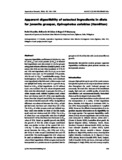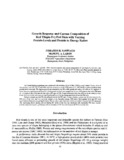Apparent digestibility of selected ingredients in diets for juvenile grouper, Epinephelus coioides (Hamilton)

View/Open
Date
2004Page views
540Metadata
Show full item recordCited times in Scopus
53 readers on Mendeley
Share
Abstract
Apparent digestibility coefficients (ADCs) for dry matter (ADCdm) and crude protein (ADCcp) of selected feed ingredients were determined in vivo for grouper using passive faeces collection (Guelph System). A reference diet (RF) and test diets (consisted of 70% RF and 30% test ingredient) with 1% Cr2O3 as an inert indicator were used. An RF contained 45% protein, 10% fat and 15.7 kJ g−1 metabolizable energy. Three isonitrogenous and isocaloric diets, each contained a test ingredient (white fish meal, white cowpea meal and ipil-ipil leaf meal), were used in a growth study based on ADCcp of feed ingredients. An RF without Cr2O3 was a control. The ADC values of experimental diets were also determined. In grouper, the ADCdm of white cowpea meal, defatted soybean meal, wheat flour and shrimp meal (74–76%) were significantly lower than that of squid meal (99%), but comparable with those of the fish meals (84–89%). No significant difference was observed between the ADCdm of ipil-ipil leaf meal, rice bran and wheat flour (56–73%). The ADCcp of white cowpea meal and defatted soybean meal were similar to those of the fish meals, squid meal and shrimp meal (94–99%). The ADCcp of wheat flour was comparable with that of ipil-ipil leaf meal (79–83%). Rice bran had the lowest ADCcp value of 43%. Based on specific growth rate (SGR), the growth of fish fed white cowpea meal-based diets was similar to that of the control fish (3.2–3.3% day−1). Also, no significant difference was observed between the ADCdm (68–72%) and ADCcp (88–91%) of white cowpea meal-based diet and the control diet. The results suggest that ADC values can be used as indicators to determine the nutritional value of feed ingredients. White cowpea meal can be incorporated as a protein source in practical diet for grouper at 20.5% of the diet with no adverse effect on growth.
Suggested Citation
Eusebio, P. S., Coloso, R. M., & Mamauag, R. E. P. (2004). Apparent digestibility of selected ingredients in diets for juvenile grouper, Epinephelus coioides (Hamilton). Aquaculture Research , 35(13), 1261-1269. https://doi.org/10.1111/j.1365-2109.2004.01148.x
Subject
animal nutrition  ; diet
; diet  ; digestibility
; digestibility  ; feed composition
; feed composition  ; feeding experiments
; feeding experiments  ; fishmeal
; fishmeal  ; growth rate
; growth rate  ; juveniles
; juveniles  ; leaves
; leaves  ; nutritive value
; nutritive value  ; proteins
; proteins  ; Epinephelus coioides
; Epinephelus coioides  ; Glycine max
; Glycine max  ; Leucaena
; Leucaena  ; Oryza sativa
; Oryza sativa  ; Triticum aestivum
; Triticum aestivum  ; Vigna
; Vigna  ; Animal protein sources; Plant protein sources; groupers
; Animal protein sources; Plant protein sources; groupers 
 ; diet
; diet  ; digestibility
; digestibility  ; feed composition
; feed composition  ; feeding experiments
; feeding experiments  ; fishmeal
; fishmeal  ; growth rate
; growth rate  ; juveniles
; juveniles  ; leaves
; leaves  ; nutritive value
; nutritive value  ; proteins
; proteins  ; Epinephelus coioides
; Epinephelus coioides  ; Glycine max
; Glycine max  ; Leucaena
; Leucaena  ; Oryza sativa
; Oryza sativa  ; Triticum aestivum
; Triticum aestivum  ; Vigna
; Vigna  ; Animal protein sources; Plant protein sources; groupers
; Animal protein sources; Plant protein sources; groupers 
Collections
- AQD Journal Articles [1248]
Related items
Showing items related by title, author, creator and subject.
-
Evaluation of fish protein concentrate and lactic yeast as protein sources for shrimp feeds
Millamena, O.M.; Triño, A.V. (Asian Fisheries Society, 1994)Protein sources, hydrolyzed fish protein concentrate and plasmolyzed lactic yeast, were used to partially replace fish meal and soybean meal, respectively, in a basal diet (diet 1) at these levels; 5% fish protein concentrate ... -
Leaf meals as protein sources in diets for milkfish Chanos chanos (Forsskal)
Borlongan, I. G.; Coloso, R. M. (Asian Fisheries Society, 1994)The protencial of partial replacement of fish meal protein with protein indigenous leaf meals in practical diets for milkfish, Chanos chanos (Forsskal) was studied. Five isocaloric (375 kcal/100 g diet), isonitrogenous ... -
Growth response and carcass composition of red tilapia fry fed diets with varying protein levels and protein to energy ratios
Santiago, Corazon B.; Laron, Manuel A. (Asian Fisheries Society, 1991)An 8-week feeding experiment was conducted with red tilapia (Oreochromis ) fry of 0.160 plus or minus 0.035 g initial weight. Twelve diets of 4 protein levels (25, 30, 35 and 40%) and 3 protein to energy (P/E) ratios (111, ...



